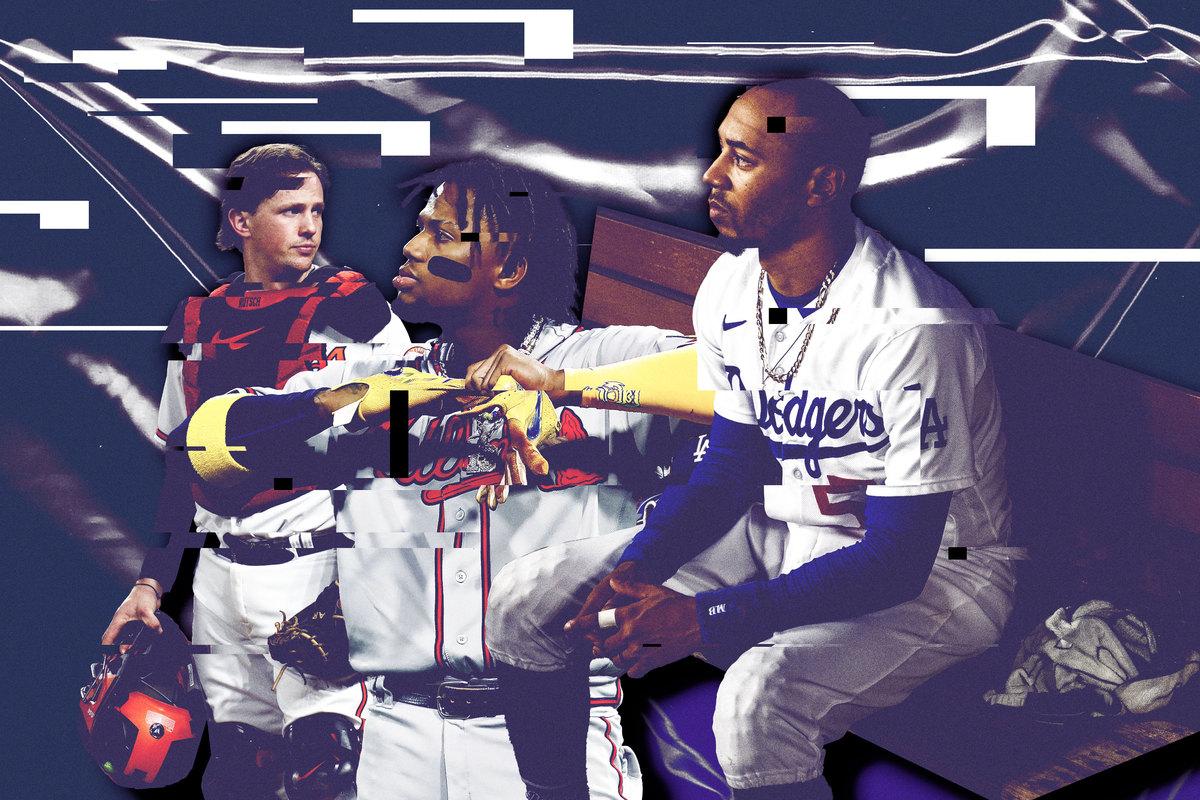
Five teams finished the 2023 MLB regular season with more than 90 wins. And all five have since been eliminated from the postseason, before the league championship series even begin.
First went the Tampa Bay Rays and Milwaukee Brewers, swept in the wild-card round. Next went the Baltimore Orioles, the 101-win no. 1 seed in the American League, falling to the 90-win Texas Rangers; then the Los Angeles Dodgers, the 100-win no. 2 seed in the National League, against the 84-win Arizona Diamondbacks, both in sweeps. The championship favorite didn’t last much longer—104-win Atlanta limped out with a 3-1 series loss to the 90-win Phillies, Atlanta’s second consecutive NLDS upset at the hands of its division rival. Only the 90-win Astros, who nabbed the AL’s no. 2 seed on the final day of the regular season, escaped the upset carnage, en route to their seventh consecutive American League Championship Series appearance.
For the first time in a full season, all four teams in the league championship series won 90 or fewer games. Clearly, the regular season didn’t provide any predictive power for the 2023 postseason: Teams that won 91-plus games in the regular season ended their collective playoff runs with a 1-13 postseason record; teams that won 90 games or fewer, conversely, tout a 21-9 mark thus far.
The MLB playoffs are inherently more random than those of other sports leagues, in both theory and practice. One study suggests that in the NBA, the best team advances in about 80 percent of playoff series; to achieve that same success rate would require a best-of-11 in the NFL, a best-of-51 in the NHL, and a best-of-75 in MLB. FiveThirtyEight calculated that more than half the time, MLB’s best team on paper doesn’t win the World Series, versus around a quarter of the time or less in other major American sports.
Yet there were also factors specific to this season, and to these three higher-seeded squads that lost in the LDS, that made their losses less shocking than the typical playoff upset. Yes, the MLB playoffs are random, but this year’s nominal favorites were beatable, too.
In two of the three series, the opponents were more even than the gulf in records indicated. Philadelphia was 12 games behind Atlanta at the All-Star break but was just two games worse than the division leader—42-31 versus 44-29—in the second half, as the likes of Philly’s Trea Turner got hot and Atlanta’s rotation faltered. In the AL, the Rangers finished the year with much better underlying numbers than the Orioles, beating Baltimore in both Pythagorean record (based on run differential) and BaseRuns record (based on the results of all plate appearances).
Orioles Vs. Rangers by Regular-Season Record
And by the time the higher-seeded losers reached October, they didn’t have the same rosters that had achieved so much in the regular season, as the attrition of pitcher injuries sapped some of their talent advantage. The list of injured starters who couldn’t throw in the playoffs for teams with more than 90 wins could fill an All-Star squad:
- Charlie Morton (Atlanta)
- John Means (Orioles)
- Walker Buehler, Tony Gonsolin, Dustin May (Dodgers)
- Shane McClanahan, Drew Rasmussen, Jeffrey Springs (Rays)
- Brandon Woodruff (Brewers)
Atlanta started Cy Young contender Spencer Strider twice in the NLDS, but its other starters were Max Fried, who had just missed two weeks due to a finger blister, and Bryce Elder, who’d already run out of steam with a 5.75 ERA (5.37 FIP) in his final 14 starts of the regular season.
Strider lost both of his starts despite a 2.84 ERA in the series, as he allowed four solo home runs. But Fried and Elder pitched considerably worse, combining to allow nine runs in 6 2/3 innings (12.16 ERA).
Elsewhere, public analysts spent all year fretting about Baltimore’s rotation, and all the Orioles did was add Kyle Gibson and Cole Irvin in the offseason and Jack Flaherty at the trade deadline. None of them made a playoff start.
And the Dodgers had the shakiest situation of all. With so many injuries, plus the absence of Julio Urías, on administrative leave under the sport’s domestic violence policy, L.A.’s NLDS starters included:
- Clayton Kershaw, who got by with smoke and mirrors (2.23 ERA versus a 5.40 FIP) after returning from injury in August and who clearly didn’t look right with a fastball that was barely reaching 90 miles per hour
- Bobby Miller, who was in strong form but was also a rookie with no playoff experience
- Lance Lynn, who led the majors with 44 homers allowed this season and wasn’t noticeably better or any less homer prone with the Dodgers after a midseason trade
Lance Lynn in 2023 Regular Season
Against Arizona, all three starters recorded more runs allowed than innings pitched, beginning with Kershaw’s one-out, six-run disaster in the top of the first inning of Game 1. Lynn allowed a postseason-leaguewide-record four home runs in a single inning—and somehow, he had the best NLDS start for any Dodger. Overall, the trio combined for a 25.07 ERA, the highest ever by far for a team with more than one postseason start.
To be fair, leaky rotations aren’t the only reason these teams lost. In particular, the offenses for Atlanta and Los Angeles, which led the majors in runs in the regular season, both faltered to the tune of two runs per game apiece—which means, in the former’s case, that we can comfortably put any “greatest offense ever” talk to rest. Atlanta tied the 1927 Murderers’ Row Yankees for the best park- and league-adjusted batting line in AL and NL history—but those Yankees scored 23 runs in their four-game World Series sweep. This Atlanta squad scored just eight runs across four contests.
Ronald Acuña Jr., Mookie Betts, Freddie Freeman, and Matt Olson—the likely top four finishers for the NL MVP award—batted a combined .137/.241/.157 in the playoffs, with only a single extra-base hit (an Acuña double) in 51 at-bats.
(It also didn’t help that aggressive substitutions from Atlanta manager Brian Snitker in Game 4 meant the majors’ best lineup in nearly a century ended its season with the tying run on base and Kevin Pillar, Eddie Rosario against a lefty, and Vaughn Grissom at the plate.)
Perhaps the extended layoff between the end of the regular season on a Sunday and the start of the NLDS on the following Saturday ruined those stars’ offensive rhythm. Such concerns have infiltrated the playoff discourse over the past week and did so last year, too, when multiple top seeds lost early and the 89-win Padres met the 87-win Phillies in the NLCS. (Never mind that the AL’s top seed, the 106-win Astros, won the 2022 World Series.) Or maybe they just had a few bad games at the wrong time, against a set of elite playoff pitchers geared up to face them.
FanGraphs found that, including this year, teams with much longer layoffs than their opponents have gone 24-11 in the first game of a playoff series—not much of an argument for the “rust” side in the “rest vs. rust” debate.
That’s not to say that there aren’t any structural problems with the current playoff format. Because the wild-card round is now a best-of-three instead of a single game, for instance, and because of extra off days built into the schedule, the wild-card winners don’t suffer any rotational deficit against the top seeds in the LDS. Any team in this best-of-five round can use its ace on full rest in a potential Game 5—even if he’s already gone in the wild-card round.
Zac Gallen pitched Game 2 for Arizona and would have been available in Game 5. Ditto Zack Wheeler for the Phillies, Jordan Montgomery for the Rangers, and Pablo López for the Twins. If anything, this setup turns Game 1 of the LDS into a pseudo-must-win for the better team—because if it loses, it then has to face the wild-card winner’s ace in Game 2.
Results don’t always shake out according to which team has the starter advantage—Atlanta lost both of the starts from Strider, its ace, while winning Wheeler’s—but it’s a concern that MLB should think about going forward. One helpful tweak in this regard would be to eliminate the off day between the third day of the wild-card round and the first day of the LDS, which would make it harder for wild-card teams to use their aces on a regular schedule—though as Ken Rosenthal notes for The Athletic, TV executives might not approve if that change required moving more wild-card games to the afternoon for travel reasons.
Rosenthal suggests a couple of other potential tweaks to the playoff format. Reseeding teams after the wild-card round, as the MLBPA reportedly proposed before the lockout, seems like an obviously good idea, to help reinforce the advantage for the best teams in each league. But his purported “ultimate answer” to rust concerns would be to expand the playoff field from 12 teams to 16, as was the case in the COVID-19-shortened 2020 season, to eliminate any extended layoff for the best regular-season teams. (This change, Rosenthal writes, could coincide with the league’s expansion from 30 to 32 teams.) In practice, though, this change would likely have the opposite effect because it would remove the advantage of a bye to automatically qualify for the LDS.
Anyone can beat anyone in a short series in baseball: In the regular season this year, the 56-106 Royals swept Houston in a series in September, while Oakland, with a league-worst 50-112 record, took two of three from Atlanta back in May. And that penchant for randomness would only be exacerbated in the playoffs, when every team is at least decent.
Back in 2020, I built a model that estimated that in a 16-team playoff field, the two no. 1 seeds would meet in the World Series only once in roughly every 15 postseasons. Two top-two seeds would meet (as 1 vs. 1, 1 vs. 2, or 2 vs. 2) in only about one in five tries. A permanent 16-team playoff field would likely devolve into March Madness–style chaos, and it could warp regular-season strategy with terrible incentives as well.
(Of course, in 2020, the two no. 1 seeds did end up making the World Series, providing only the second 1 vs. 1 matchup this century. But there was also plenty of other weirdness in the 2020 postseason—including very few off days, which emphasized pitching depth and might have helped the Dodgers and Rays outlast their opponents.)
Perhaps MLB wouldn’t mind a March Madness–style free-for-all characterized by even more upsets and even more Cinderella glides through October. League executives haven’t resisted regularly expanding the playoff field for the last three decades, from four teams to eight in 1995, to 10 in 2012, and to 12 in 2022. The question is what the league wants its postseason, and its championship, to be—a crowning achievement for the undisputed best team in the sport, or an unpredictable tournament that is just as entertaining for its unpredictability?
The MLB postseason can’t simultaneously satisfy owners who want an expanded playoff field, TV executives who want staggered series and off days, and fans who want the best team to win the title. The top seeds in 2023 might have been aberrantly vulnerable, which helped tilt the result toward upsets, but the very structure of the sport creates an environment ripe for short-series shockers. We can’t have a fretful reckoning every time a high seed loses early because this kind of October surprise will keep reoccurring until it shouldn’t really register as much of a surprise at all.

